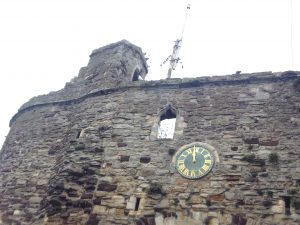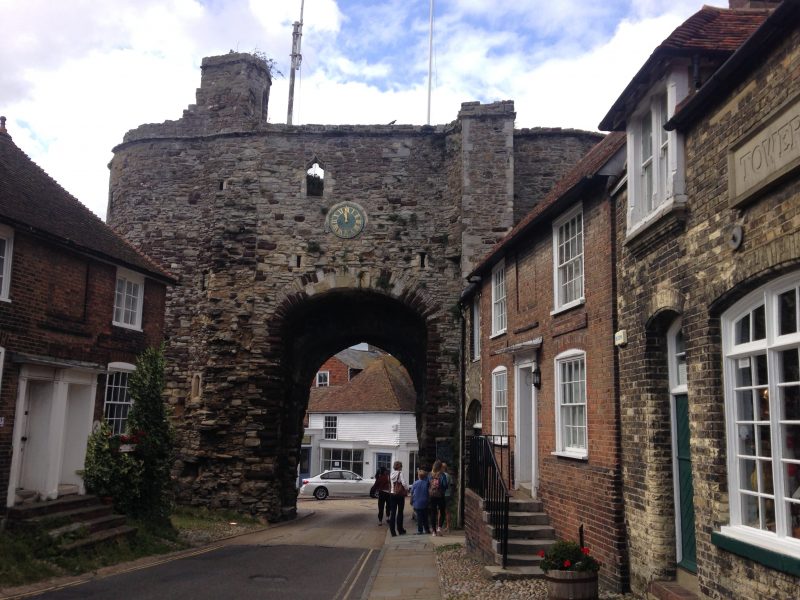Rother District Council (RDC) has released the long awaited “Outline Vision Document for the Landgate”, and called a meeting of interested parties for Monday, November 27, as reported in Rye News last week.
This document is of importance to everyone interested in the future of the Landgate. It was commissioned by RDC, which owns the Landgate, from Thomas Ford and Partners, who “specialise in the conservation, repair and reuse of historic buildings with a sustainable future”. .
The Landgate is a structure of outstanding historical and cultural significance and is seen by many as a symbol of the town of Rye. It is a Listed Grade 1 Ancient Monument and an integral part of the 14th century town defences. The document includes some fascinating detail about the structure itself. East Sussex County Council owns the road underneath the arch.

The report author writes: “The vision for the Landgate is to ensure its long term repair and maintenance, ideally greater public access and appreciation and ensure it remains at the heart of the town of Rye. RDC also wishes to see responsibility for the Landgate pass to another organisation, better suited to its longer term care”
This last sentence is echoed throughout the document. RDC is the legal owner of the Landgate and, as such, responsible for its maintenance and repair, under both Scheduled Monument and Listed Building Legislation. This is clarified later by the document’s author, John Bailey. He undertook the inspection, followed by a detailed specification and schedule for repair, for Thomas Ford and Partners and says:
“It is clear RDC do not have the financial resources to maintain the structure, even as a controlled ruin – a new way forward has to be found to safeguard the structure”
The roof, removed in the 18th century, has meant that the Landgate has been kept as a controlled ruin. It is a landlocked structure and access to it is very limited. Whilst RDC have a legal and moral obligation to maintain this cultural assets, the need to repair has to be balanced by the availability of funds.
The necessary repairs are laid out, split into four categories with all the work needed. Written in March 2015, it notes that the structure is fundamentally sound, but will not remain so if these are not addressed. There are works due urgently to safeguard the historic fabric; works due within the next two years; works due within the next five years and works that should ideally be undertaken. The costs range between £300,000 to over £400,000, depending on whether this is done in a single phase, so giving economies of scale, with the costs of one contract, or as four separate contracts undertaken at different times.
So, what are the options for the repair strategy and possible future use?
The first is, of course, to do nothing, as there is no significant money available for repairs in the very short term. There are major objections to this, including the health and safety obligation and the possible public liability or even road closure, if falling material injured a member of the public. This means that costs to ensure safety and remove guano would still have to be met annually.
Next, a controlled pragmatic repair to maintain a ruin. The work to tackle the repair backlog would be undertaken, in either a single phase or multiple phases. This is an option preferred by many residents and argued cogently in an article written for the Rye Conservation Society. Substantial finance would be needed either from RDC or an unnamed third party. Periodic repair about every 30 years would be required to undertake larger conservation issues.
Repair and alteration, adding value with public access, is the last one. This assumes a repaired, converted Landgate, reroofed and with public access, to allow educational use, with the aim of an independent financial future. This would enable educational activities, views across the town and public ownership, with an income and future maintenance funding. Note is made that this approach might well need the purchase of an adjacent property to allow such access.
Four ways of funding this are suggested, with their advantages and disadvantages. In brief:
RDC resources, coming out of already stretched budgets: Donor funding, finding a philanthropist to fund works without expectation of financial return or reward, seen as unlikely: A commercial venture, relying on a business putting in a significant amount of capital, for financial return, also unlikely. It would also put “unreasonable pressure” on the Landgate for change and development. The most favourable option was grant funding, with the obvious candidate being the Heritage Lottery Fund. This last would need a clear answer to public access, an educational element, a sound business case for future liability and lines of governance and ownership. All these options are argued in detail in the document.
The suggested way forward? The author, John Bailey, thinks there are four ways of securing the Landgate’s future. It does, however, depend on RDC finding and entering into an agreement with an unnamed third party, an approach adopted by other organisations. This agreement would mean that the third party ultimately takes over ownership of the structure from RDC and has the capacity and resources to undertake that role.
The report recommends that a financially viable way for both care and potential use be explored, and discussions with an external funder be undertaken, to establish how to secure funds and that RDC may need to provide monies to make this occur. In any case, this will need a clear vision for the Landgate, with strong local support and involvement which will allow ownership, to enhance the chances of such a project being successful.
There are many views on what should happen eventually to the Landgate, and this “Outline Vision Document”, written by an independent organisation, has more and very interesting detail. It now gives the residents of Rye time to reflect and request the full document, so that comment can be made to RDC directly about the options suggested. It is expected to be fully discussed at Monday’s meeting.
Photo:Gillian Roder




It is a pity that RDC appear to have ducked their statutory responsibility to maintain the Landgate – and ironic that if it was successfully added to the national “Buildings at Risk” Register the body that would have to enforce repair is – RDC! The big question is whether there is any use for the Landgate that could generate income to maintain it. There is no point in a local group taking it over if it remains a financial millstone. Readers should be reminded that Rye Conservation Society’s Executive Committee have discussed possible uses for over six years and despite the wealth of professional expertise on the Committee (architects, surveyors etc) it has failed to envisage any possible use. Without making major alterations – which it is unlikely, given its status as a Scheduled Ancient Monument, to be permitted – access is effectively impossible. As Julian Luckett has pointed out in a parallel article, anyone thinking of taking over the Landgate should be mindful of the maintenance costs, the insurance costs and the costs of staff if it were somehow to be opened to the public. The capital cost of a full internal renovation for active use runs into seven figures, which I fear is a sum quite outside the compass of local fundraising when there is little prospect of any financial return.
Thus RCS’ view that it should be preserved as a consolidated ruin, which a much smaller sum expended to keep it watertight (and keep the pigeons out) is not a negative attitude but a sensible and pragmatic one. The Society has considered funding restoration of the clock – but this is only possible if it is protected from the elements. It does show, nonetheless, the Society’s commitment to making the best of the Landgate that is practical. Those who think that a local takeover is a good idea should first consult the good citizens of Winchelsea and learn of the major issues they have faced since accepting responsibility for their gates.